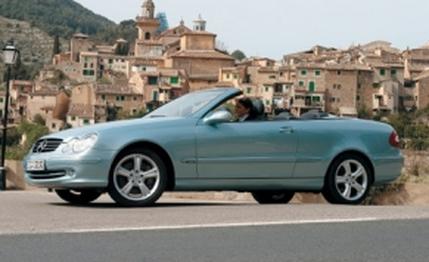
 First Drive Review
First Drive Review
A fabric convertible top functions in the automotive design world a lot like well-chosen wallpaper does in home renovation: It's supposed to make things it covers look better.
Consider this Mercedes CLK. When its fixed-roof twin arrived last fall, we quibbled about its swollen dimensions, higher roofline, and departure from the flying-wedge profile that defined the original CLK. Replace that body-color tintop with a contrasting, smoothly sculpted fabric roof, however, and the height is visually diminished, allowing the eye to appreciate the lower body's rising beltline. Depress a console-mounted switch or a button on the remote fob for 20 seconds, and the fabric disappears beneath a sculpted tonneau cover (complete with rear-seat headrest fairings), and the CLK begins to resemble a topless Mercedes CL, a delicacy only your favorite Sawzall surgeon can deliver.
Why a fabric top instead of the folding hardtops that now grace all other Mercedes roadsters? According to CLK-class development V-P Michael Krämer, designing a metal top to cover such a large four-seat cabin would require too many separate panels-each with an unsightly seal-and stowing them would consume the entire trunk. A compact fabric top scrunches to make room for a best-in-class trunk volume of roughly 14 cubic feet with the top up, 10 with the top down (official SAE specs are not yet available). A larger backlight and slimmer C-pillars approximate hardtop visibility, offering drivers a panoramic view of 85 percent of the horizon when the top is up.
The idea of offering a removable hardtop for winter use was dismissed because the fabric top has an inch-thick, six-ply layer of top insulation that locks in warmth and muffles noise. Mercedes claims the new top, along with improved aerodynamics (the drag coefficient drops from 0.32 to 0.30), endows the CLK cockpit with best-in-class quiet, registering interior noise levels that are hushed by 2 dBA at 100 mph. We merely noted that at that speed, with the top up, we were able to converse in, if not library volumes, then classy-restaurant tones, and with the top down and the windows and the wind blocker up, at a busy-bistro timbre.
Of course, more interesting than most 100-mph conversations in a CLK is the experience of getting to and from that speed. This happens most quickly in the high-performance tuner model, the CLK55 AMG, which is newly invigorated with 362 horsepower (a 20-horse promotion). Its 376 pound-feet of torque strain at the stability control, traction control, electronic differential, and other e-leashes whenever the driver applies egg-crushing pressure to the accelerator. To AMG's credit, however, these electronic aids are calibrated to allow the driver to point the car with the throttle before serious intervention kicks in. And using AMG's more obedient Speedshift manumatic buttons behind the steering-wheel spokes, the driver can shift up to a gear in which full throttle won't send electrons scurrying to cut the power. Drop the hammer fully, and AMG reckons you'll pass the mile-a-minute mark in just under 5.4 seconds while the exhaust sings the sweetest snarl we've heard in a Mercedes since a piece of road shrapnel holed the header pipe in a recent S500 test car.
The mass-produced V-8 in this year's CLK is the 302-hp, 5.0-liter that motivates the CLK500 at a pace equal to that of last year's CLK55 AMG-6.2 seconds to 62 mph on the factory's clock-while fuel economy (about 20 mpg on the European combined test) inches upward relative to last year's CLK430 V-8. The mainstream 3.2-liter V-6 is unchanged, although the axle ratio is shortened 12 percent to cope with the 240 pounds the new CLK gained in the process of becoming bigger and better.
Regarding the chassis, the seemingly retrograde move away from control arms to struts in front is somewhat compensated for by the savvy switch from recirculating-ball to rack-and-pinion steering, not to mention some crack tuning of the 12-percent-stiffer chassis. We never found a bona fide pothole during our 170-mile drive crisscrossing the sunny Mediterranean isle of Majorca off the Spanish mainland, but the mild wrinkles and ripples we did encounter excited only slightly more shimmying in the CLK's dash than one finds in the billet-milled SL roadster's.
There is still no mistaking the CLK's handling for that of a BMW 3-series-the Mercedes feels larger and a bit more relaxed, especially in steering feel-but the path accuracy and the limit handling grip are superb. Ride quality in all three models struck us as equal to or better than that of the equivalent Bimmer ragtop, especially at the AMG/M3 level.
Figure in a larger back seat (that is, after all, a major reason for choosing a CLK over an SLK or SL) that more comfortably accommodates mid-size adults, plus improved safety features such as optional rear side-impact airbags, taller head-and-body side airbags in front, and pop-up roll-over protection-all at prices that are expected to start at $50,000 for the CLK320, and progress through $58,000 for a CLK500, and $76,000 for the AMG-and this starts to look like a lovely way to redecorate the garage this September.